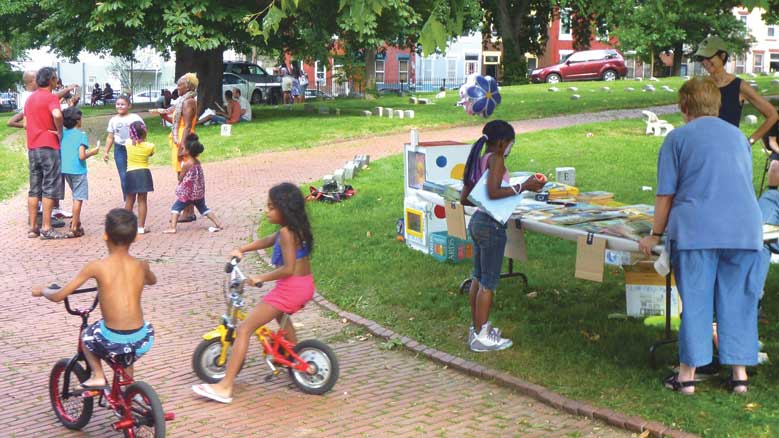
Partnering History and a Neighborhood
“There is a sweetness in the air here,” remarked the photographer for a local newspaper. He had come to Philadelphia’s Fair Hill Burial Ground for its annual summer festival to take a few photos but couldn’t resist lingering. The afternoon was warm and sunny; the gardens were in full bloom, and the tomatoes were ripening in the vegetable plots. The towering oaks and recently planted fruit trees provided welcome shade. There was laughter from children running about with colorfully painted faces. They were clutching new books, drinking freshly made lemonade, and eating organic wraps and locally made chili. The pony rides and dancing horses had come and gone, and as the sun lowered, the live music began. Everyone settled in to savor the last of the day: a sweetness indeed.
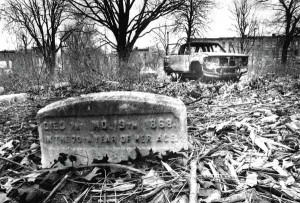
Twenty years ago, who would have predicted that the atmosphere of this four-and-a-half-acre square city block—an historic Quaker burial ground that had fallen into dereliction—could ever be described this way. At that time, it was the largest open-air crack cocaine market in Philadelphia. By the mid-1980s, the neighborhood was so notorious for its crime and drug dealing that it was dubbed “The Badlands” by the local media. Margaret Hope Bacon described the scene in a 1999 Friends Journal article:
a tangle of weeds, discarded tires, trash, and garbage, surrounded by a gap-toothed fence and gutted sidewalks, a menace to an already decaying neighborhood. On its northeast corner drug dealers gathered like flies, while their clients used the burial ground to shoot up. Neighborhood children were kept indoors to avoid the flying bullets of gang warfare.
The story of transformation from dereliction to community is a remarkable one. A core group of dedicated Friends came together as Historic Fair Hill (HFH) with determination and a sense of mission to turn this overgrown dumping ground—a haven for criminal and drug activity—into a neighborhood oasis. With the restoration of the burial ground as a catalyst, and with support from local elected officials, churches, city agencies, and concerned community members, the burial ground has become not only an open green space in an area ravaged by poverty and blight but also a steadfast leader and partner in the Fairhill neighborhood community.
The burial ground is the final resting place of human rights giants, among them Quakers Lucretia and James Mott; Robert and Harriet Purvis (abolitionists who ran an Underground Railroad station); and Anna T. Jeanes, a philanthropist who made possible Jeanes Hospital (through a provision in her will) and the Negro Rural School Fund. The mission of Historic Fair Hill organization is to assure that the ideals of the remarkable people interred here continue to speak to the world.
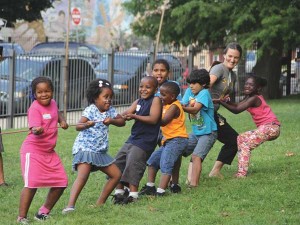
Today HFH has transformed the small corner of the world in which it is located. In addition to maintaining the beauty and safety of the physical space, it operates a calendar of community events, encompassing educational partnerships with local schools, literacy programming, field trips, tree planting, community clean-ups, nature and history tours, community gardening, environmental projects, and leadership programs for youth and adults. It is an example of Quaker values put into practice, but it is also a prototype for how an historic site can work with its present-day surrounding community.
The gardens at the burial ground have grown bigger every year, extending into neighboring plots at the request of the community. They are open three days a week from May through October. During these months, HFH gardeners work and welcome visitors. Children and adults from the community come to garden, frolic on the grass, ride bikes along the carriage paths, play board games, read and mingle on one of the seven benches, or just relax in the leafy shade.
The gardens are abundant. Last year they produced 800 pounds of fruits, vegetables, and herbs. There is a “three sisters” garden of heirloom corn, beans, and squash that were grown by the Lenni Lenape, the original inhabitants of the site. Next to it tomatoes, collards, and kale abound, and European and Puerto Rican herbs lend their scents to the air. In 2013 the gardens were awarded second place in the community vegetable garden category in the City Gardens Contest sponsored by the Pennsylvania Horticultural Society (PHS).
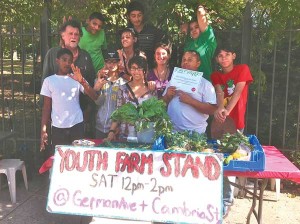
The HFH Youth Program engages neighborhood young people in a farm internship. These young adults care for the site, including gardening and cleanup. They participate in field trips and life education activities, and learn to work together as a group. On the same corner that was once home to dealers selling drugs, they operate a farm stand, selling some of their organic “Fair Hill Grown” produce and distributing the rest through the neighborhood.
In the spring and fall, neighborhood schools come for field trips. On a beautiful fall day, a class of kindergarten children walk the four blocks down Indiana Avenue from Potter-Thomas School. As they turn into the garden, they see a huge leaf pile, their eyes as big as saucers, and ask, “Can we jump in that?” For five minutes it is gleeful pandemonium as the children leap and laugh and throw armfuls of leaves into the air. Then they continue exploring in what, for this morning, is a magical city block: searching for pine cones and acorns, watching hawks and squirrels, swinging on the tree swing, feeding the birds, climbing a small tree, putting their hands into fresh rosemary and mint, and holding a worm.
Over 215 teachers are buried at the Fair Hill grounds, and a critical part of the mission is to reach out to neighborhood schools, offering literacy, gardening, and nutrition partnership programs. Sixty-seven percent of children in the Fairhill zip code live below the poverty line; one in four has a close family member who is incarcerated. The area’s poverty rate is the highest in the city, and the unemployment rate hovers at 26 percent.
At Potter-Thomas School alone the impact of these programs is felt. Adult “reading buddies” are paired with young readers in kindergarten and first grade, to provide reading support, conversation, and encouragement to eager children. For some of the children this is the only one-on-one reading time they have, and it is exhilarating to see their progress over the course of the year.
Through the generosity of Friends schools and organizations in the Philadelphia area, Historic Fair Hill collects books that have turned the understocked Potter-Thomas library into a lively reading hub. Many of the books have been culled from their own collections, and increasingly they also come from book drives of students and parents. At Christmas, each book from Friends’ Central School in Wynnewood, Pennsylvania, came with beautiful handmade bookmarks, with glitter and tassels and words of encouragement for “reading, reading, reading.” Through the dedication of a teacher who staffs the library (there is no professional librarian), these books are added to the collection, placed in classrooms, and given as gifts to individual children to keep and take home. The children’s eyes light up as they see the books being unpacked, and they eagerly ask if they can take one “right now.”
Each February, Historic Fair Hill sponsors a Black History Month essay contest for students to practice their writing and public speaking skills. This project encourages Fairhill students in grades four through eight to learn about the individual heroes who are buried in their neighborhood and to honor their contributions by writing an essay on a specific topic. HFH brings the community together for a public presentation of the winning essays.
A few years ago, through HFH, the Philadelphia Eagles chose Potter-Thomas for their 2009 Playground Build, and the Philadelphia Mural Arts Program painted bright, beautiful murals around the buildings. HFH supported the landscaping: trees, a formal perennial border, and flowering shrubs to make the school grounds beautiful. A few years later a new teacher was looking for a teaching position in the Philadelphia schools and drove by: “Someone loves this school; I want to come here,” she thought and picked the school.
Historic Fair Hill has developed numerous partnerships with community organizations throughout the city, including the PHS Tree Tenders program (planting trees), the Schuylkill Valley Nature Center (field trips), Congresso (summer camps), and Broad Street Ministry (bringing youth groups from churches in other states to spend a day in the Fairhill neighborhood). Students from Temple University are volunteering in increasing numbers.
Events continue year round. In October, the Orchard Harvest Festival celebrates the garden’s bounty. The Franklin Institute holds well-attended astronomy nights in the spring and fall that educate children and adults about the wonders of the night sky. In December, Historic Fair Hill ushers in the holiday season with the lighting of two large stars at both corners of the burial ground on Germantown Avenue, then people unite around a bonfire to sing Christmas carols and enjoy hot chocolate and gingerbread cookies baked by the youth group. During the darkest season of the year, the stars with their battery operated lights serve as a beacon of joy for the community and for thousands of passersby along this once dark section of Germantown Avenue.
This corner of the world has been a Quaker concern for 300 years. With the dedication, vision, and hands-on work of many Friends and neighbors, the Fair Hill Burial Ground stands today as a vibrant, educational, safe, green, and abundant space.
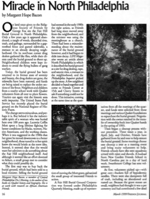 Web Extra:
Web Extra:
Read “Miracle in North Philadelphia” (PDF) Margaret Hope Bacon’s 1999 Friends Journal article on the Fair Hill Burial Ground.


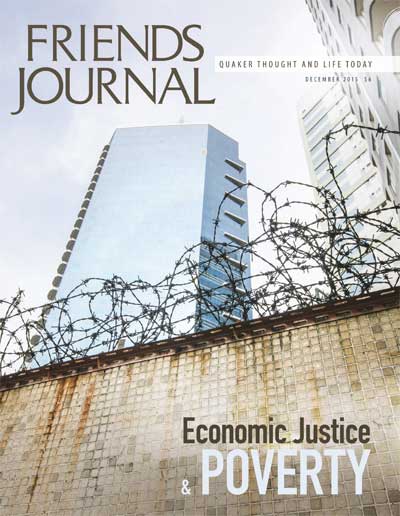
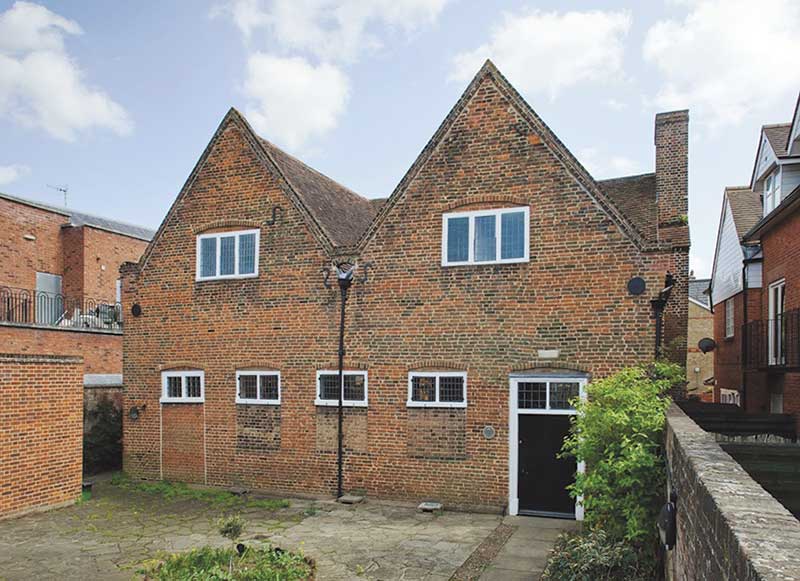

Comments on Friendsjournal.org may be used in the Forum of the print magazine and may be edited for length and clarity.